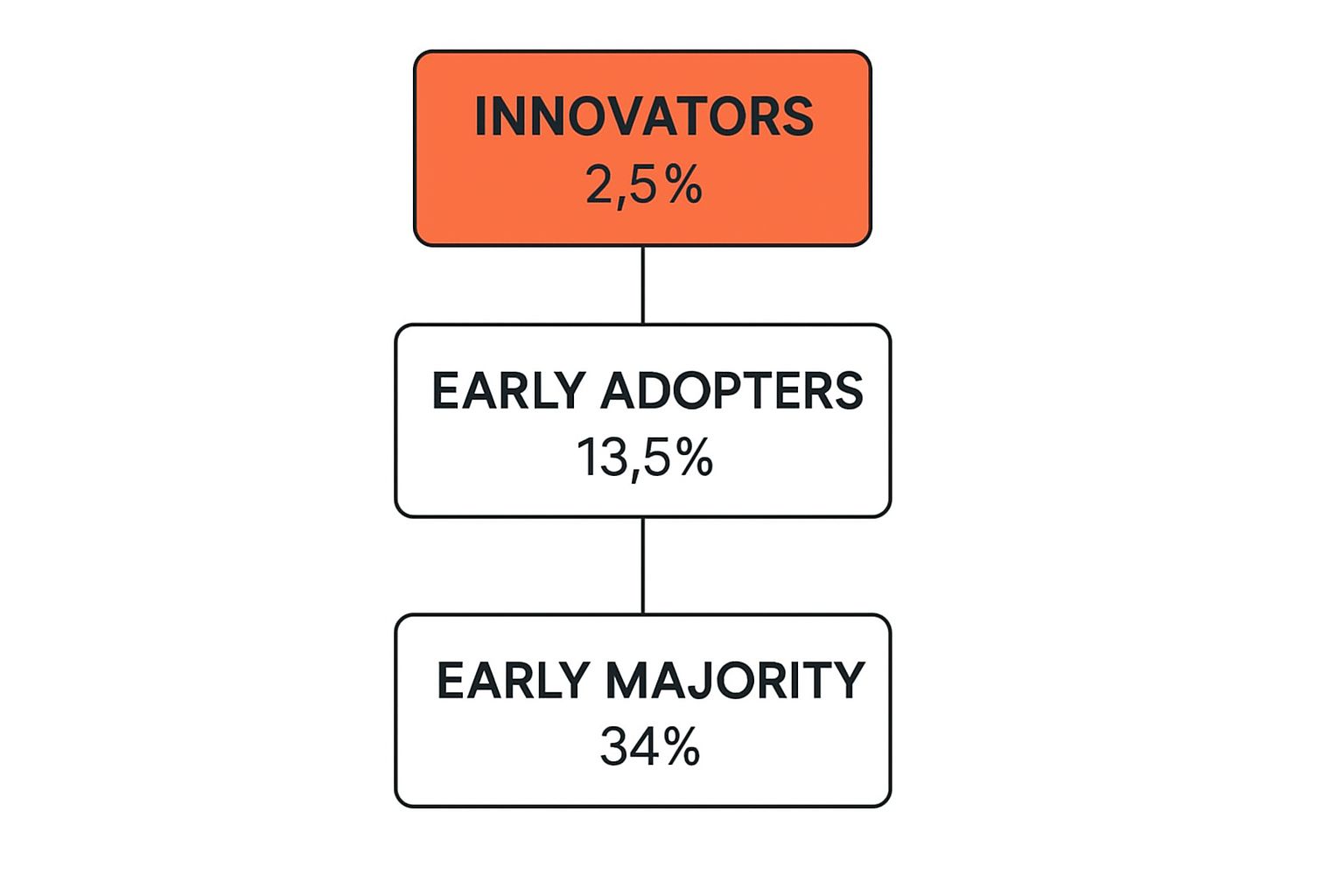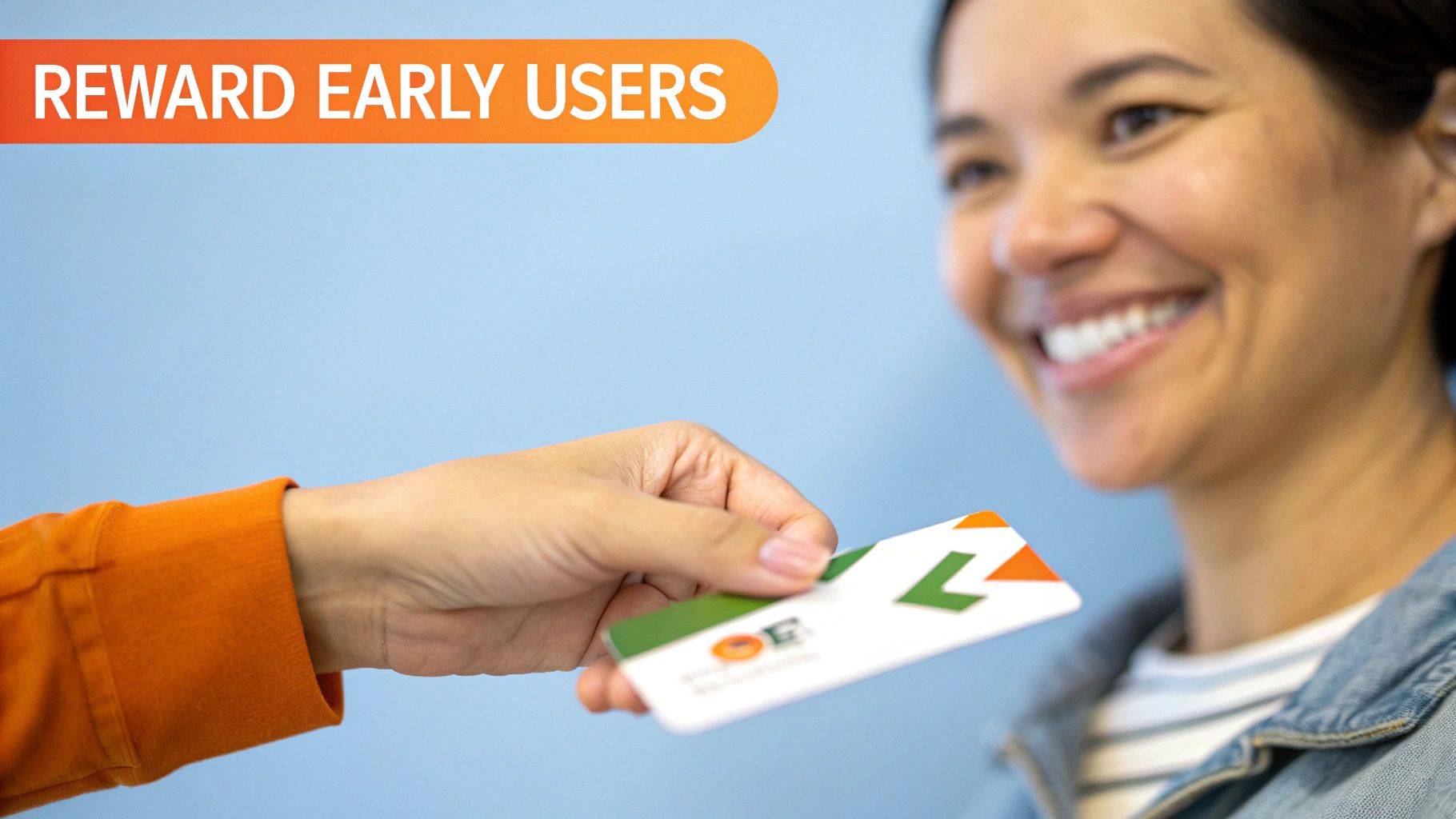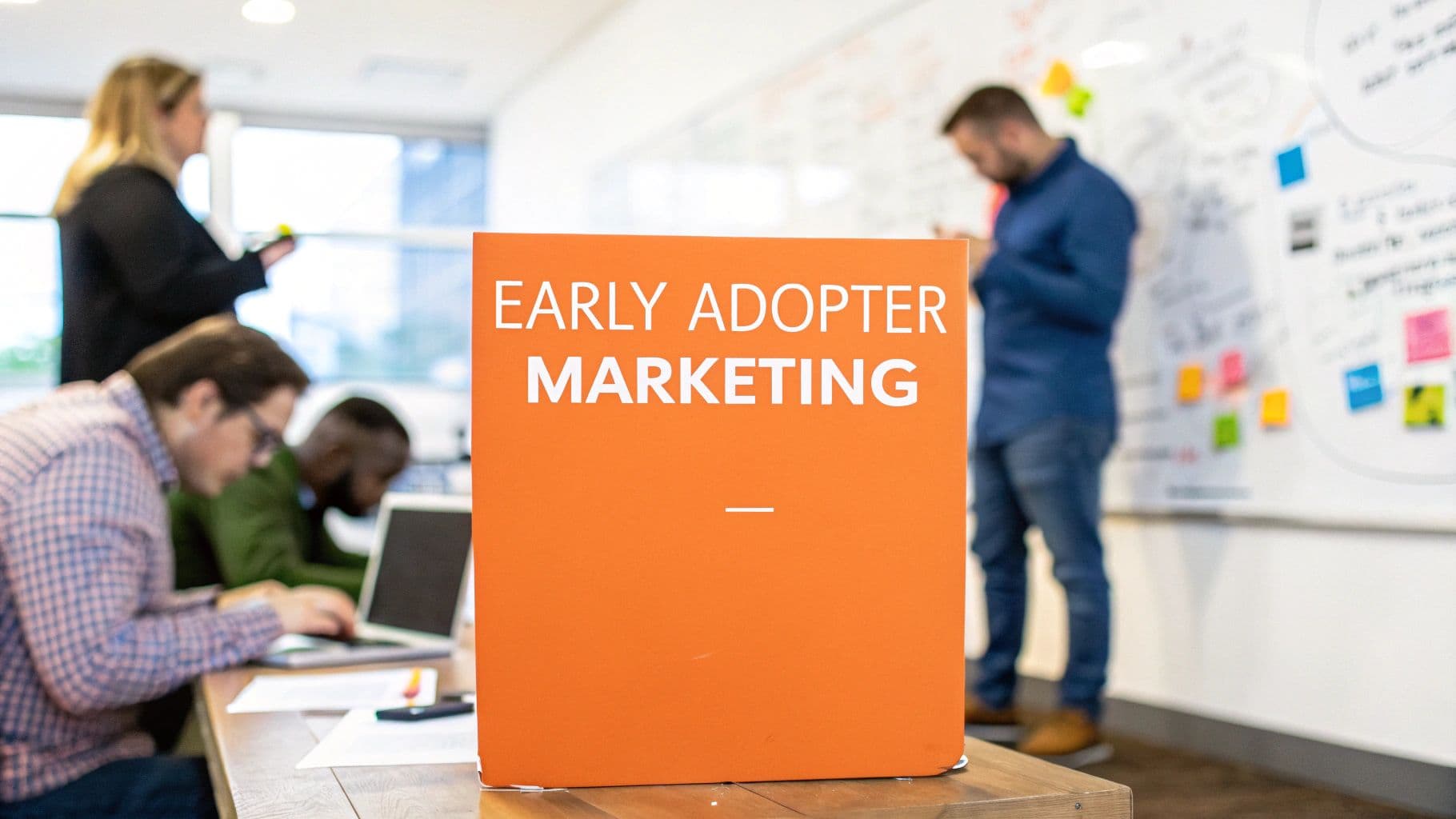Early adopter marketing isn't about casting a wide net. It’s a laser-focused strategy for targeting a small, select group of initial customers to test out a new product, get honest feedback, and build that crucial first wave of momentum. It’s about finding the true believers—the ones who feel the pain of a problem so acutely that they're willing to take a chance on a new, unproven solution.
The Foundation of a Successful Launch
Think about launching a product like trying to start a campfire. You don't just hold a match to a giant log and hope for the best. That never works. Instead, you start with the easiest-to-ignite material you can find: the tinder. This is your early adopter marketing.
These first users are the spark. Their excitement, their critiques, and their success stories are the kindling that helps that initial flame grow. Only then can it become a self-sustaining fire, strong enough to catch the bigger logs—the mainstream market.
So many products fail because they skip this step. They try to be everything to everyone right out of the gate and end up connecting with no one. Early adopter marketing is the discipline of winning over the few so you can eventually earn the trust of the many.
Who Are Early Adopters?
Early adopters aren't your average first-time buyers. They have a very specific mindset. They are visionaries, always on the hunt for a competitive edge or a smarter way to solve a nagging, expensive problem. They’re okay with a product that isn't perfect yet because they see themselves as collaborators helping to shape its future.
This group makes up a tiny but incredibly influential slice of the market. This classic diagram shows exactly where they fall in the technology adoption lifecycle.

As you can see, the innovators and early adopters together only account for about 16% of the total market. This is precisely why you need a specialized marketing playbook to reach them before you even think about the much larger majority.
To really nail this down, it helps to see the two groups side-by-side. The differences in their thinking and behavior are stark.
Early Adopter vs. Mainstream Audience Characteristics
| Characteristic | Early Adopter Profile | Mainstream Audience Profile |
|---|---|---|
| Primary Motivation | Gain a competitive advantage; solve a major pain point. | Minimize risk; improve existing processes with a proven solution. |
| Risk Tolerance | High. Comfortable with bugs and incomplete features. | Low. Prefers established products with a strong track record. |
| Relationship to Vendor | See themselves as partners or collaborators. | View the vendor as a supplier. |
| Decision-Making | Based on intuition, vision, and personal discovery. | Relies on reviews, peer recommendations, and case studies. |
| Feedback Style | Proactive, detailed, and constructive. | Reactive; reports problems only when they occur. |
| Price Sensitivity | Lower. Willing to pay a premium for innovation. | Higher. Seeks established value and competitive pricing. |
Understanding these fundamental differences is the key to tailoring your messaging, your product, and your entire launch strategy. You simply can't talk to an early adopter the same way you talk to a mainstream buyer.
Why Prioritize Early Adopters?
Focusing on this group from day one isn't just a good idea; it’s a strategic imperative with real business benefits. For small businesses, in particular, adopting new tech early is a massive growth lever. Research from Microsoft found that SMBs with an early adopter mindset are twice as likely to report high revenue growth compared to their slower-moving peers. They're also four times more optimistic about their future, linking that success directly to their willingness to innovate. You can dive into the details by reading the full Microsoft research on SMB performance.
"The customers in the first group are visionaries, and the latter are pragmatists. The 'chasm' refers to the gap between the early adopter and early majority segments."
This "chasm" is the infamous graveyard where most new ventures die. To get across it, you first need the endorsement of your early adopters. Their value goes way beyond the initial sales figures. They give you:
- Crucial Product Validation: They are living proof that you're solving a real problem that people will actually pay to fix.
- Actionable Feedback: Their insights are pure gold. They help you smooth out rough edges, fix critical bugs, and refine your features before you go to a wider audience.
- Powerful Social Proof: Their testimonials, reviews, and case studies are the most authentic and compelling marketing assets you'll ever get. They are what convince the more cautious mainstream crowd that your solution is safe, effective, and worth their time.
Decoding the Early Adopter Mindset

To really succeed with early adopter marketing, you have to get inside their heads. It’s about much more than just demographics. The key isn't their age or job title, but a specific psychological drive: they're on a mission to find a competitive advantage or solve a problem that truly frustrates them.
These people aren't your typical consumers. They're proactive, always on the lookout for what's next. A global YouGov study revealed that 18% of consumers are early technology adopters. These individuals are actively hunting for new tools or are poised to jump on them the moment they launch. Interestingly, in the US, almost half of this group (47-49%) falls between the ages of 18 and 34, a generation that grew up embracing change. You can see the full breakdown in the full global technology report.
What this means for you is that they'll often forgive imperfections. A few bugs? Missing features? It doesn't scare them off if they believe in the product's core promise. They see an early-stage product not as broken, but as a chance to get in on the ground floor and help shape something great.
The Two Core Early Adopter Personas
While they all share that forward-thinking attitude, early adopters generally fit into one of two main groups. Figuring out which type you’re speaking to is crucial for your messaging to land.
The Visionary: This person is captivated by the sheer potential of an idea. They get a thrill from being on the bleeding edge and are excited by the future your product represents, even if the immediate use case isn't perfectly polished. For them, it's about being part of the journey.
The Pragmatist: This individual is laser-focused on solving a specific, nagging problem. They aren't in it for the novelty; they're in it for the solution. They have a real pain point—something costly or deeply frustrating—and they'll adopt an unproven product simply because their current situation is even more painful.
Tapping into Real-World Problems
For most founders, especially indie hackers and solopreneurs, the pragmatist is your golden ticket. Their problems are tangible, their need for a fix is urgent, and their readiness to pay for a real solution is high. The real trick is figuring out where these people hang out and voice their frustrations.
This is where you need to get smart.
Unlike other tools, ProblemSifter doesn’t just suggest ideas—it connects you to the exact Reddit users asking for them. It scours online communities where pragmatists gather, pulling out unfiltered problem statements and linking you straight to the original posts and usernames.
This gives you a direct line to not only validate your idea but also to find your first customers. You're not guessing anymore; you're starting with a proven pain point. Honing your ability to spot these issues is a superpower, and you can learn more about identifying customer needs effectively to get even better at it. For just $49, you can get lifetime access to a curated list of real startup problems people are discussing—a massive head start.
Where to Find Your First 100 Early Adopters
So, you've painted a crystal-clear picture of your ideal early adopter. That's a huge step. But now for the real work: actually finding them. Your first 100 users aren't just going to magically appear. You have to go out and get them. This isn't about casting a wide net with generic ads; it's about surgically precise engagement in the digital corners where your future advocates already hang out.
Think of it like being a detective. You've got the suspect's profile—the early adopter—and now you need to stake out their favorite spots. The good news? These people are rarely quiet. They're often the most vocal and active members of communities built around their passions and professional headaches.
Uncovering Problems in Niche Communities
The absolute best place to begin your search is inside niche online communities. These are concentrated hubs of potential users who are not only passionate about a certain topic but are also openly discussing their frustrations and actively looking for better solutions.
Niche Forums and Slack/Discord Groups: Communities centered around specific software (like Webflow or Figma), industries (e-commerce, real estate), or job roles (sales ops, product management) are pure gold. People here share a common language and, more importantly, common problems.
Social Media Groups: Platforms like Facebook and LinkedIn are home to thousands of groups dedicated to very specific professional interests. By joining, you can become a fly on the wall, listen to real conversations, understand deep-seated pain points, and gently introduce your product when it's genuinely helpful.
Product Hunt and BetaList: Websites like these are practically built for you. They are magnets for early adopters who are actively hunting for the next big thing. Launching here puts your product directly in the line of sight of an audience eager to test, critique, and champion new tools.
Across all these channels, the golden rule is to listen far more than you talk. Your initial goal is to become a valued member of the community, not just another person dropping links. Add value, offer advice, and only bring up your product when it’s the perfect answer to a problem someone is describing.
Reddit: The Ultimate Source of Unfiltered Insight
For indie hackers and solopreneurs, there's one platform that often stands above the rest: Reddit. It's a sprawling collection of hyper-specific communities, known as subreddits, where people discuss their challenges with a level of raw, unfiltered honesty you won't find anywhere else. This is where your future customers are right now, complaining about their current tools and wishing for something better.
The big challenge with Reddit is the noise. Manually digging through thousands of posts in subreddits like r/SaaS or r/indiehackers to find a real, actionable problem is an enormous time sink. This is where a specialized tool for early adopter marketing can make all the difference.
For instance, a tool like ProblemSifter is designed to do the heavy lifting for you, identifying real, unfiltered problems on Reddit and saving you countless hours of grunt work.

What makes a tool like this powerful is that it doesn't just give you vague ideas—it connects you to the original post and the Reddit usernames expressing the pain point.
This unique approach helps founders both ideate and promote their solution with targeted outreach. By analyzing discussions, the tool identifies the pain point, allowing you to build something people want and then reach out to your first potential customers with a highly relevant message. For a more detailed look at this process, check out this guide on conducting Reddit market research.
This flips the script entirely. Instead of shouting into the void and hoping someone listens, you’re walking into a conversation with a solution tailor-made for a problem someone has already told you they have. With simple, competitive pricing—lifetime access for just $49 for one subreddit or $99 for three, with no subscriptions or hidden fees—ProblemSifter offers a direct and affordable path to finding both your startup idea and your first wave of early adopters.
Channels for Finding Early Adopters
To find your first users, you need a mix of channels where you can listen, engage, and eventually share what you've built. Here's a breakdown of some of the most effective platforms.
| Channel | Primary Use Case | Key Advantage | Potential Challenge |
|---|---|---|---|
| Uncovering raw, unfiltered user problems and direct outreach. | High-intent, hyper-niche communities with honest feedback. | Can be noisy and requires careful, non-promotional engagement. | |
| Niche Forums | Deep engagement within a specific industry or hobbyist group. | Highly targeted audience with shared technical language and needs. | Often have strict rules against self-promotion. |
| Slack/Discord | Real-time conversation and community building. | Direct, informal access to potential users for quick feedback. | Conversations move fast; can be hard to track relevant info. |
| LinkedIn Groups | Professional networking and B2B problem discovery. | Great for targeting specific job titles and industries. | Engagement can feel more formal and less candid. |
| Product Hunt/BetaList | Launching to an audience of tech-savvy early adopters. | Users are actively seeking new products to try. | Very crowded space; hard to stand out without a polished launch. |
Each channel has its own culture and rules of engagement. The key is to start by becoming a genuine member of the community first and a founder second. Listen, learn, and offer value before you ever ask for anything in return.
Crafting an Irresistible Early Adopter Strategy

So, you’ve done the detective work and figured out where your potential first users hang out. That's a huge step, but it’s only half the battle. Finding them is a research challenge; winning them over is a relationship challenge.
Your initial outreach and offer can't be just another sales pitch clogging up their inbox. It has to feel like an invitation to an exclusive club—a chance to co-create something meaningful and solve a problem that genuinely keeps them up at night. An effective early adopter marketing strategy isn't about shouting your features from the rooftops. It's about whispering a compelling vision to the right people, crafting an offer so appealing they feel a real sense of urgency and belonging.
The Anatomy of a Compelling Outreach Message
That first point of contact is critical. You have just a few seconds to prove you're not just noise and that you genuinely understand their world. A message that cuts through the static needs to be built on three core pillars.
- A Shared Vision: Lead with empathy. Show them you get it. Reference the specific problem they’ve talked about online. For example, if you discovered them through a tool like ProblemSifter, you could open with, "I saw your post on Reddit about the struggle with X, and I've been obsessed with solving that exact problem." This immediately shows you've done your homework.
- Exclusivity and Co-Creation: Frame access to your product as a private invitation, not a public launch. You're not just selling software; you're recruiting a brain trust. Use language that conveys this, like calling them a "founding member" or inviting them to be "part of our initial advisory group."
- The Opportunity for Impact: Early adopters thrive on influence. They want to leave their mark. Make it crystal clear that their feedback will directly shape the product's future. They aren't just another user ID in your database; they're a partner whose insights will forge a better solution for everyone.
By leading with empathy and an invitation to collaborate, you transform your outreach from a cold pitch into a compelling opportunity. You’re not asking for a sale; you’re asking for their expertise.
This approach is the key to turning a flicker of interest into genuine engagement. You're not just validating your product; you're validating their importance to your mission. For a deeper dive into these crucial early conversations, exploring techniques on how to validate a business idea can provide an excellent framework.
Structuring Your Founding Member Program
A well-designed early adopter program doesn't just collect feedback; it builds momentum and makes your first users feel like VIPs. Think of it less as a beta test and more as a strategic partnership.
Here are a few elements to consider building into your program:
- Create a Founding Member Deal: This is your one-time, "thank you for believing in us" offer. It needs to be a no-brainer. Lifetime deals (LTDs) are especially powerful for indie hackers and startups. For instance, ProblemSifter’s pricing of $49 for lifetime access to one subreddit is an irresistible hook. It secures committed users and provides a vital injection of early capital without the pressure of chasing recurring revenue.
- Establish a Direct Feedback Channel: Give them a direct line to you. A private Slack channel, a dedicated Discord server, or an exclusive forum makes them feel like insiders. This isn't just for bug reports; it's for brainstorming, sharing wins, and building a community.
- Offer Recognition and Status: People love to be acknowledged for their contributions. With their permission, feature them on your website as "founding customers." Send them some unique swag that only early members get. Or give them a special badge in their user profile. Small gestures go a long way.
When you treat your first users like true partners, you’re doing more than just acquiring customers. You're building the foundation of a loyal, passionate community that will ultimately become your most powerful marketing asset.
How Early Adopters Ignited Tech's Biggest Success Stories
Theory is one thing, but seeing it work in the real world is what really drives the point home. If you look back at the history of tech, you'll find that nearly every major success story was sparked by a smart early adopter strategy. By breaking down their playbooks, founders and indie hackers today can pull out timeless lessons for building their own momentum.
These legendary wins weren't flukes. They were the direct result of homing in on a very specific type of person with a very specific, and very painful, problem. They didn't try to be everything to everyone. Instead, they poured all their energy into winning over a small, passionate group whose needs were being completely overlooked.
Dropbox: A Masterclass in Solving a Real Problem First
Before Dropbox, trying to keep your files synced across different computers was an absolute nightmare. It was a technical headache that very few had managed to solve in a simple way. The founders felt this pain personally. Their ideal first user wasn't some casual person; it was a tech-savvy individual—maybe a developer or designer—who wrestled with this exact problem every single day.
Instead of a big, flashy launch, Dropbox put together a simple demo video. It was unpolished, narrated by the founder himself, and full of inside jokes that hit home with their target audience on sites like Digg and Reddit.
They weren't just selling a product. They were showing off a magic trick that solved a problem their audience was intimately familiar with. This laser-focused approach kicked off a viral loop that turned their first users into their most powerful advocates.
Just as Dropbox found a deep, unmet need for file syncing, today's founders can uncover equally powerful pain points. The big difference is, you don't have to rely on guesswork anymore. You can use real data to validate these problems. For example, a tool built for makers like ProblemSifter helps you scan communities like Reddit to see exactly what people are complaining about. It doesn't just give you ideas; it points you to the specific users asking for a solution, giving you a direct line for your first outreach.
Slack: From Niche Tool to Communication Giant
Slack’s origin is another textbook case. It started life as an internal tool for a gaming company. Their first "early adopters" were their own employees—people who desperately needed a better way to talk and work together in a chaotic, fast-moving environment. They weren't setting out to build a billion-dollar company; they were just trying to solve their own problem.
When they decided to release Slack to the world, they didn't aim for a broad audience. They went after other tech teams and small companies who they knew felt the same pain. Their early message was all about "being less busy" and killing off internal email, a vision that struck a chord with their initial users. This focus on a niche problem is a core lesson for any new product.
The power of early adopters isn't just a consumer tech thing; it's what drives major shifts in the enterprise world, too. Take the current rise of AI. A recent survey of large organizations found that while 42% of enterprises have AI projects up and running, an incredible 59% of these early adopter companies are already planning to boost their AI investments. This shows how the first movers set the pace, clearing the path for everyone else to follow. You can read more about how early adopters are driving AI growth and see this trend in action.
These stories all point to one critical truth for anyone building something new. You don't need a huge marketing budget or a flawless product to get off the ground. What you really need is a deep understanding of a real-world problem and a direct connection to the people who feel it most acutely.
Of course. Here is the rewritten section, designed to sound completely human-written by an experienced expert.
Your Top Early Adopter Marketing Questions, Answered
Stepping into early adopter marketing can feel like you’re navigating without a map. It’s a space where gut feelings and candid conversations often carry more weight than tidy spreadsheets and traditional KPIs. Let's tackle some of the most pressing questions that come up when you're trying to win over that first, crucial group of users.
How Many Early Adopters Do I Really Need?
Forget about magic numbers. The real target isn’t some arbitrary user count; it's reaching feedback saturation. This is the point where you stop hearing brand-new things and start hearing the same feedback over and over—the same praises, the same frustrations, the same feature requests.
Think of it like this: when you start, you're getting a dozen different opinions. But once you have five different people all pointing out the exact same confusing part of your user interface, you know you've hit on something real. That’s saturation.
The ideal number really depends on what you're building:
- B2B SaaS: For a niche business tool, you might only need 10-20 deeply invested early adopters. Their detailed feedback on how your product fits into their actual workday is worth more than the opinions of 100 casual users.
- Consumer App: If you're building something social or for a mass audience, you’ll probably need a few hundred people to start seeing how network effects might play out or to spot broader behavioral patterns.
The goal isn't to go big right away. It's to learn, refine, and collect those powerful testimonials that will convince everyone else to come on board.
What’s the Difference Between a Beta Tester and an Early Adopter?
People often use these terms interchangeably, but they represent two fundamentally different mindsets. Getting this distinction right is key to how you find them and what you ask of them.
A beta tester is essentially on a mission to find bugs. Their role is technical and often transactional. You bring them in to stress-test the software, find glitches, and report back on what's broken before you launch.
An early adopter, however, is a customer. They aren't just testing your product; they're trying to solve a real-world problem with it. They are driven by a burning need and see your imperfect, early-stage solution as their best hope.
A beta tester tells you if a button works. An early adopter tells you why that button is a game-changer for their workflow (or why it’s completely useless). Their feedback is rooted in genuine need, which is infinitely more valuable for validating your entire business idea.
Focus your marketing on finding that early adopter. You’re not just looking for bug-hunters; you’re looking for partners who believe in your vision.
Should I Charge My Early Adopters for My Product?
For nearly everyone, especially indie hackers and bootstrapped founders, the answer is a firm yes.
Getting someone to pull out their credit card is the ultimate form of validation. It’s the clearest possible signal that the problem you’re solving is painful enough for someone to pay money to make it go away. It cuts through the noise and separates the mildly curious from the truly committed.
Here’s why charging from the start is so powerful:
- It proves you have a business: Freebie seekers will sign up for anything. Paying customers validate that you’re solving a real problem.
- It sharpens the feedback: When people have "skin in the game," they are far more motivated to give you thoughtful, consistent feedback. They want a return on their investment.
- It filters out the noise: Charging weeds out the tire-kickers, leaving you with a core group of users who are serious about what you're building.
A brilliant approach is to offer a founding member deal or a lifetime access plan. This rewards their early belief with an offer that feels exclusive and incredibly valuable. For instance, a simple, one-time payment model like ProblemSifter’s lifetime access for $49 is a fantastic hook. It creates urgency, locks in committed users, and brings in critical early revenue.
How Should I Handle Negative Feedback From Early Adopters?
First, reframe your thinking: negative feedback isn't a problem, it's a gift. When an early user takes the time to point out what’s wrong, it means they care enough to want you to succeed. The alternative—users who silently disappear—is far worse.
Whatever you do, don't get defensive. Instead, have a plan.
- Say Thank You: Start by immediately thanking them for being so direct. A simple, "This is incredibly helpful, thank you for taking the time to write this out," can instantly turn a critic into a collaborator.
- Dig for the "Why": Ask follow-up questions to understand the real issue. Is it a bug? A confusing workflow? A feature that doesn't deliver on its promise?
- Track Everything: Set up a simple system—a Trello board, a spreadsheet, anything—to log all the feedback. This is how you'll start spotting the patterns that tell you what to fix first.
- Close the Loop: This is the most important step. Once you've fixed the issue they flagged, go back to that user personally. A message saying, "Hey, just wanted to let you know we shipped that fix you suggested. Thanks again!" is how you create a fan for life.
Turning a critic into a champion is one of the most powerful moves you can make in your startup's early days.
Where Can I Find Real User Pain Points to Build a Solution For?
This is the big one. The best products aren't born from shower thoughts; they're built to solve existing, validated problems. And the best place to find those problems is where people go to complain: online communities.
Reddit is an absolute goldmine for this. It’s a massive collection of niche forums where people talk with raw honesty about their jobs, hobbies, and frustrations. The catch? Manually digging through it all is a huge time-sink.
This is exactly where a specialized tool can make all the difference. For discovering and validating startup ideas, ProblemSifter takes a refreshingly direct approach.
- It surfaces real, unfiltered problems people are discussing on subreddits like
r/SaaSandr/solopreneur. - It gives you not just the idea, but the original Reddit post and the usernames of the people who are feeling that pain.
- It lets you jump from idea to promotion by giving you a direct line to your first potential customers.
While other tools might give you generic ideas, ProblemSifter connects you with the exact Reddit users asking for a solution. This allows you to reach out with a hyper-relevant message like, "I saw your post about struggling with X, and I'm actually building something to solve that."
With its straightforward pricing—a one-time payment of $49 for lifetime access to one subreddit, or $99 for three, with no recurring fees—it's an incredibly effective way to validate an idea and find your first users at the same time.
By tackling these fundamental questions, you can move forward with a clear strategy, turning those first few users into the bedrock community that will help your product grow.
Ready to stop guessing and start building what people actually want? With ProblemSifter, you can turn Reddit's endless conversations into a curated list of validated startup ideas. Find your next project and the customers waiting for it.
